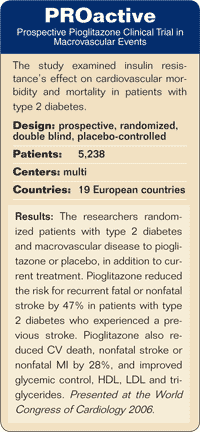Pioglitazone reduced stroke risk in patients with type 2 diabetes, previous stroke
PROactive substudy: Patients had a stroke six months prior to treatment.

Pioglitazone reduced the risk for recurrent fatal or nonfatal stroke by 47% in patients with type 2 diabetes who experienced a previous stroke, according to Robert G. Wilcox, MD, head of the department of cardiovascular medicine at Queens Medical Centre in Nottingham, England.
Pioglitazone reduced CV death, nonfatal stroke or nonfatal MI by 28%, and improved glycemic control, HDL, LDL and triglycerides.
Wilcox presented data from a subgroup of patients included in the Prospective Pioglitazone Clinical Trial in Macrovascular Events (PROactive) trial at the World Congress of Cardiology 2006. The researchers designed PROactive to analyze the effect of pioglitazone on mortality and macrovascular morbidity in patients with type 2 diabetes who are at high risk for macrovascular events.
Stroke risk reduced
For the PROactive trial, the researchers randomized 5,238 patients with type 2 diabetes and macrovascular disease to receive an addition of either pioglitazone or placebo to their current treatment. Pioglitazone or placebo therapy lasted for a median of 2.85 years. Current therapy included antihypertensives, antithrombotic agents, diet, glucose-lowering agents and lipid-altering agents.
The subgroup analysis included 984 patients who had a stroke at least six months prior to treatment; 486 patients were included in the pioglitazone group and 498 were included in the placebo group.

The researchers defined primary endpoint as time from randomization to first occurrence of at least one clinical and procedural composite event, including all-cause mortality, acute coronary syndrome, nonfatal MI, stroke, leg revascularization, major leg amputation above the ankle and cardiac intervention, such as CABG or percutaneous coronary intervention.
The researchers found a 10% relative risk reduction in the pioglitazone group compared with the placebo group (P=.095).
They defined the secondary end point as time from randomization to first occurrence of any events in the major adverse cardiovascular events clinical composite, including all-cause death, nonfatal MI and stroke. They found a relative risk reduction of 16% in the pioglitazone group compared with the placebo group (P=.027), according to Wilcox.
Strong predictor
A multivariate analysis showed that prior stroke was the strongest predictor of recurrent stroke in the entire cohort (HR=2.88; P=.0001). Pioglitazone use and statin use significantly affected the risk for recurrent stoke in patients with a history of previous stroke (P=.0076 and P=.0126, respectively). The researchers also found that age, HbA1c at least 7.5%, creatine at least 130 mcmol/L and peripheral arterial disease were positive predictors of first stroke in patients with no history of previous stroke, Wilcox said.
The researchers found no differences between the pioglitazone group and placebo group with regard to serious adverse events, according to Wilcox. They found that reports of serious HF increased in the pioglitazone group; however, they found no difference in the number of deaths among these patients, he said.
Wilcox recommended further study to determine whether patients with type 2 diabetes without a history of prior stroke or patients without diabetes would benefit from longer-term therapy with pioglitazone.
This article also appeared in Today in Cardiology, a SLACK Incorporated publication.
For more information:
- Wilcox RG. Effects of pioglitazone in patients with or without a history of stroke: an analysis of PROactive. Presented at: World Congress of Cardiology 2006; Sept. 2-6, 2006; Barcelona.
